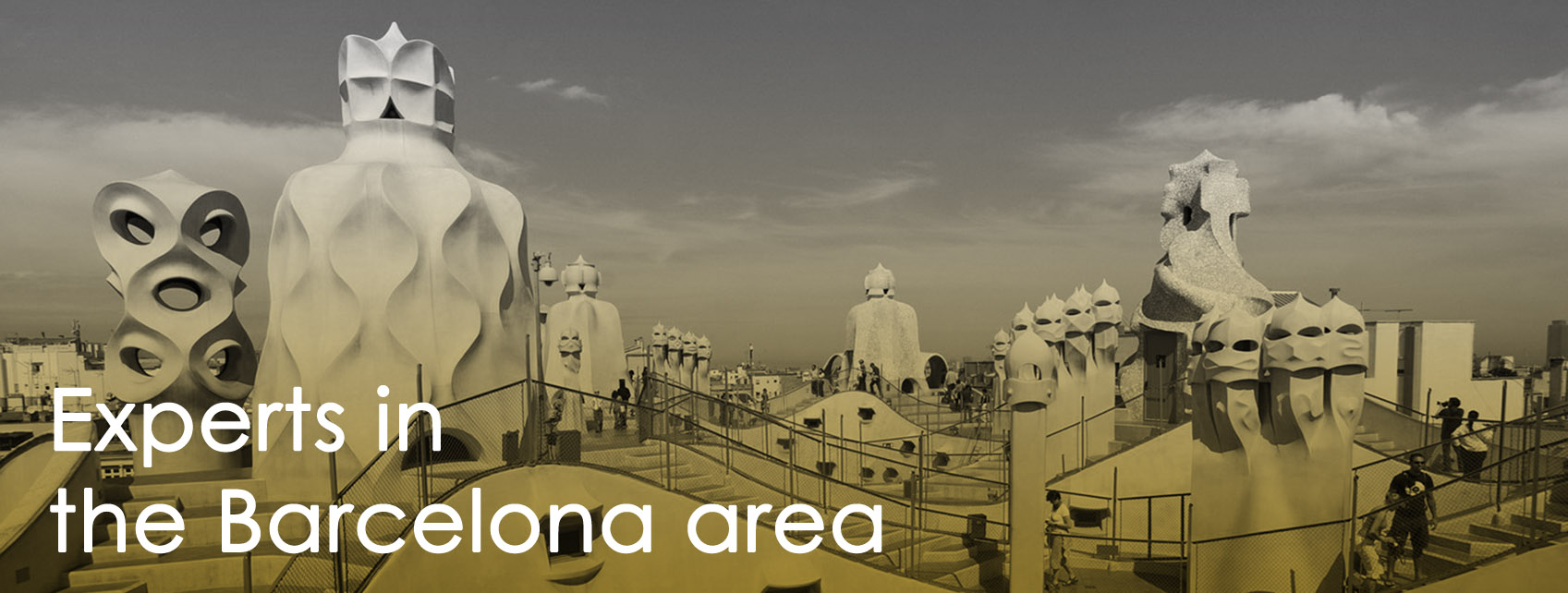Inside Barcelona
When buying or renting a home, one of the most decisive factors to consider is location. Once the purchase or the rental is closed, it will not be possible to change the location for some time, so it is very important to previously learn about the area where we’re going to have live. The social activity in the area where you will reside isn’t probably the same during the week than on the weekend, it may be different during rush hour and at the end of the day, so it is key to know if this is really where you want to be spending a great deal of your time.
However, you may not have the opportunity to learn about the area before buying or renting a home. For this reason, we offer Inside Barcelona, where we try to bring to you the most important history of each district of Barcelona, the most emblematic places, how public transport is distributed and the trends of each neighborhood nowadays. We want you to have an idea of how each district is, if it is more residential, more historic, more commercial area…
Our goal is no other than helping you be the one who ends up deciding which district suits you best.
Barcelona districts
Les Corts is a district located in the west side of the city, at the end of Avenida Diagonal. It is amde up of three districts: Les Corts, Sant Ramon-Maternitat and Pedralbes.
Les Corts is known to be a residential area, with several shopping centres and cultural and sport facilities. One of the most charming aspects of this district are the fair amount of parks and the proximity to Collserola.
Most famous places are: FC Barcelona stadium, with its world wide known museum, located right below the Diagonal; the Palau Reial de Pedralbes.
‘’Los pabellones Guell’’ located in the upper part of Pedralbes, created by Antoni Gaudí ‘’El monasterio de Santa Maria de Pedralbes ‘’, belonging to the fourteenth century that has the gratest gothic style of Europe.
We can also enjoy La Casa de la Maternitat, with its beautiful gardens and its modernist buildings; ‘’ la Zona Universitaria’’, located on the Avinguda Diagonal with ‘’ los jardines del Palacio de Pedralbes ‘’; ‘’ El parque de Cervantes’’ and ‘’ El parque Can Rigal’’, a park full of many green areas.
Accessibility
Metro L3 L9S
Tram T1 T2 T3
Horta-Guinardó is the third largest district in Barcelona and it is divided into several different neighborhoods: the Guinardó, Baix Guinardó, Can Baró, Font d’en Fargues, Carmel, Teixonera, Horta, Vall d’Hebron, Sant Genís dels Agudells, Montbau i la Clota.
It is mainly a residential and entertainment oriented district.
Horta-Guinardo still preserves the rural touch that has historically characterized this district. Narrow streets, small houses, and probably a more peaceful environment than in the rest of the city.
You can visit ‘’El Barri de la Clota’’ where you can still find big farmhouses and majestic houses well preserved and converted for a different use.
You can also find the great maze ‘’ Laberint d’Horta’’ with a panoramic view of Barcelona.
Accessibility
Metro L3 L4 L5
Nou Barris is located in the north of Barcelona and is formed by 13 districts.
It’s an area composed of steep and irregular streets and wide assormtents of gardens. This neighborhood stays away from the noise of Barcelona, with bars and a lot of lifelong establishments.
It is characterized by a wide range of cultural activities, the people who live here are very active in trying to bring all sort of improvements to the neighborhood.
We can find points of interest like ‘’Parc Central’’, the second biggest park in Barcelona, located in the Guineueta with a big municipal library; the Parc de Can Dragó located in Porta, perfect for kids and with a reserved space for dogs; even older items, such as ‘’ Aqüeducte Ciutat Meridiana’’, the Rec Comtal, Castell de Torre Baró, which has one of the best viewpoints to watch the entire city.
Accessibility
Metro L3 L4 L5 L11
Renfe R3 R4 R7
Gràcia, located in the center of Barcelona, is one of the busiest districts and with a very active social life.
Gràcia district is characterized by small streets and many squares full of restaurants and bars their typical terraces to enjoy the outdoors.
It would be accurate to say that it is the most bohemian and cosmopolitan district of Barcelona.
Within this district you can walk to the world famous ‘’Parc Güell’’, one of the most important works of Antonio Gaudi.
Accessibility
Metro L3 L4 L6 L7 L12
Railway S1
Sant Andreu is located in the east of Barcelona.
Its one of the districts that keeps its traditional character.
We can find beautiful cobbled streets, shops that remain for many years and even Roman remains.
Sant Andreu is an industrial district, shows a lot of character which is portrayed in old buildings like ‘’ la Fábrica de creación Nau Ivanov’’ or ‘’ la Fábrica i Coats’’, that currently are used to promote different cultural events.
Accessibility
Renfe R2 R3 R4 R7
Metro L1 L9N L10
Ciutat Vella was the first district of Barcelona. It is characterized by its streets and squares with great historical value.
It is made up by 4 neighborhoods: Barri Gotic, the oldest neighborhood in Barcelona; El Born (barri Medieval), which includes ‘’Sant Pere’’, ‘’Santa Catarina’’ and ‘’La Ribera’’; El Raval, which is an extension of the medieval walls; and la Barceloneta, a sailors neighborhood of the eighteenth century near the port.
This district offers most of the tourist´s attractions of Barcelona: La Rambla Boulevard, where you can take great walks; the Parc de la Ciutadella, where we find the Barcelona Zoo and other emblematic buildings or statues; Mercat de la Boqueria, the largest market in Catalonia and with more variety of products; or the Barcelona Museum of Contemporary Art (MACBA).
Accessibility
Renfe R1 R2 R3 R4
Metro L1 L2 L4
The Eixample district is located in the center of Barcelona and contains the main boulevards of Barcelona.
It is divided into five neighborhoods , characterized by octagonal streets.
The neighborhood of Dreta de l’ Eixample, with Plaça Catalunya, Passeig de Gràcia and Rambla de Catalunya, which are probably the most important areas for shopping. You can also admire buildings like the Casa Batllo or Casa Mila, known as La Pedrera, probably two of the most visited buildings in the entire city.
The neighborhood of the Eixample Esquerra, is divided into the Antiga Esquerra, a residential área which aldo offer some green areas, and also where you can find the Faculty of Medicine; and in the Nova Esquerra, with la fábrica de Can Batlló, reconsturcted in a Industrial School and ‘’el parc de Joan Miró.
The Sant Antoni neighborhood, is characteristic for its market and its youthful atmosphere, you can often find people exchanging objects of all kinds.
The Fort Pienc, where you can find the Arc de Triomf and great walks, where people usually go to practice sports or for leisure activities.
And finally, the Barri de la Sagrada Familia, where you´ll find perhaps the best known monument which happens to be one of the most recognizable buildings in the world. The Sagrada Familia was built by Antoni Gaudí becaming one of the most emblematic modernist buildings and tourist attractions .
Accessibility
Metro L1 L2 L3 L5 L8 L9S
Renfe R1 R2 R3 R4 R5 R6
Railway S4 S8 S33
Sants-Montjuïc is the district that is located more in the south of Barcelona. It includes seven neighborhoods where we can enjoy both mountain and sea…
You can find some neighborhoods with an industrialized profile such like Marina and Bordeta, where you can find’’ la antigua fábrica de Can Batlló’’. Other neighborhoods are more colorful and hold small houses such as as Poble Sec, perfect area to go for a drink in any of its bars. Avinguda Paral·lel, where you´ll find the best theatersin the city. ‘’La montaña de Montujïc’’ with its impressive views. Or Barrio de Sants with its extraordinary public transport.
Also we can not forget the important points like Plaça Espanya, the second largest plaza in Spain; the Font Magica, located in Montjuïc with iys amazing lighting and water fountain effects; el Palau Nacional, where El museo d’Art Nacional de Catalunya is located; el Pabellón Alemán de la Exposición, a pioneer of the modern movement; Poble Espanyol, architectural outdoor museum; the Palau Sant Jordi which holds all kinds of sporting events, concerts and performances take place; la Torre de Comunicacion known as the Calatrava Tower; the Caixa Forum, a cultural center for social work; or la fundación Miró, with the most representative works of the world known painter.
Accessibility
Metro L1 L2 L3 L5 L8 L9S
Renfe R1 R2 R3 R4 R5 R6
Railway S4 S8 S33
The Sarria-Sant Gervasi is one of the largest, and north located districts of Barcelona.
In the old days this area was where the wealthiest and more influential people of the city lived, this is evident since you can still see today several palaces and modernist houses well preserved.
One of the best ways to travel across this district is by Tramvia Blau, through the Avinguda del Tibidabo, which exhibit many gardens and impressive mansions, and finishing in ‘’El templo expiatorio del Sacré coeur.
Without any doubt, this is a residential district that enjoys green areas. On top of that, Collserola is in this disctrict, thanks to its fountains and parks it probably makes this area become the best district to disconnect fom the noisy center and enjoy the outdoors.
However, we can also visit many other attractions like ‘’ La Torre Bellesguard’’ , built by Antoni Gaudí; ‘’el Parc de l’Oreneta’’, ideal for the little ones; or la ‘’Torre de Collserola’’ standing at 289 meters high.
Finally, one of the most important points to consider is the ‘’Parc del Tibidabo’’, an amusement park with amazing views of Barcelona.
Accessibility
Railway S1 S2
Metro L7 L12
Sant Martí district is situated in the coast of Barcelona, and undoubtedly is the mediterranean district, with its beaches and great boardwalks.
You can still see the industrial past that characterized the district not so long ago, made obvious by the many high chimneys that spread throughout the neighborhood. Fort he last few years this has been shifting and the most prevalent feature right now are the many main streets that run down the entire neighborhood and lead into the seafront.
Surely, Sant Marti is the perfect district to observe the great change that has suffered Barcelona over the years.
One of the most important points is the remodeling of Poble Nou with the construction of the Technological Zone known as 22@, where different universities, research centers and a lot of innovative companies have settled. One of the most outstanding buildings in this district is Torre Agbar, a representative building of the modern Barcelona.
Very important to point out is the recovery of the beaches that has been carried out recently, or the union of la avenida Diagonal to the sea. As well as the building of the Forum, la Villa Olimpica or el Port Olimpic.
Accessibility
Tram T4 T5 T6
Metro L1 L2 L4 L5




